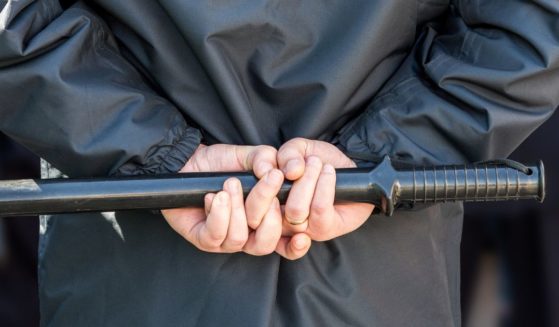US Fighter Jets Intercept Russian Bombers Approaching American Airspace
Six Russian warplanes were intercepted by U.S. jets Monday after they flew into the Alaskan Air Defense Identification Zone in a tactic the commander of the North American Aerospace Defense Command says will continue to be repeated.
A NORAD press release said the U.S. put four F-22s and an E-3 Airborne Early Warning and Control System in the air to intercept four nuclear-capable Tupolev Tu-95 bombers and two Su-35 fighters.
The Alaskan Air Defense Identification Zone extends 200 miles west of the state’s physical borders.
NORAD said the Russian incursion began with two Tu-95 bombers, to which two F-22s responded. A second pair of Russian bombers, escorted by two Su-35 fighters, was then intercepted by two more F-22s.
The Russian planes “remained in international airspace and at no time did the aircraft enter United States or Canadian sovereign airspace,” NORAD said in its release.
“NORAD’s top priority is defending Canada and the United States. Our ability to deter and defeat threats to our citizens, vital infrastructure, and national institutions starts with successfully detecting, tracking, and positively identifying aircraft of interest approaching U.S. and Canadian airspace,” said Air Force Gen. Terrence J. O’Shaughnessy, who commands NORAD. “NORAD is on alert 24 hours a day, seven days a week, 365 days a year.”
NORAD fighters intercepted Russian bombers+fighters entering Alaskan ADIZ May 20. 2x Tu-95s were intercepted by 2x F-22s; a second group of 2x Tu-95+2x Su-35 was intercepted later by 2 more F-22’s; NORAD E-3 provided overall surveillance. The aircraft remained in int’l airspace pic.twitter.com/VrNuSWFOQm
— North American Aerospace Defense Command (@NORADCommand) May 21, 2019
Russia did not deny the incident.
The Russian Ministry of Defense tweeted that the Tu-95 bombers “made scheduled sorties over the neutral waters of the Chukotka, Bering and Okhotsk seas, as well as along the western coast of Alaska and the northern coast of the Aleutian Islands. At certain stages of the route, Russian aircraft were escorted by #F22 fighter jets of the #USAF. The total flight time exceeded 12 hours.”
At certain stages of the route, Russian aircraft were escorted by #F22 fighter jets of the #USAF. The total flight time exceeded 12 hours
— Минобороны России (@mod_russia) May 21, 2019
Russian jets often fly near the American coast, O’Shaughnessy said in written testimony submitted to Congress earlier this month, CNN reported.
“Patrols by Russian military aircraft off the coasts of the United States and Canada have grown increasingly complex in recent years,” he wrote.
O’Shaughnessy says the Russian flights are a “highly visible” message intended “to underscore Russia’s capabilities” and develop “a new generation of air crews.”
“NORAD fighter aircraft routinely intercept Russian military aviation missions inside the U.S. and Canadian Air Defense Identification Zones, and there is no indication that Russian leadership intends to reduce the number of these missions in the near future,” he wrote.
O’Shaughnessy last year said America’s traditional distance from potential enemies is not what it used to be, according to Military Times.
“We’re in a changing security environment,” O’Shaughnessy said in a speech at the 140th National Guard Association conference. “We used to think about the sanctuary we had with oceans and friendly countries to our north and south, but that’s changing with adversaries that are actually able to reach out and touch us now.”
“We have to think about our defense in different ways than we have in the past. That means we need to fundamentally re-think when we say homeland defense how we’re going to do that against a peer competitor,” he added.
In February, O’Shaughnessy said that both China and Russia are now potential concerns in the Arctic region, according to Military Times.
He said both countries have “established a noticeably stronger foothold in the Arctic along the northern approaches to the United States and Canada. As a result, the strategic value of the Arctic as our first line of defense has re-emerged and USNORTHCOM and NORAD are taking active measures to ensure our ability to detect, detract and defeat potential threats in this region.”
The latest incident comes as NATO is preparing for exercises on Russia’s doorstep, according to NATO. The Summer Shield exercise will be held in Latvia from June 2 to June 15, and is followed by a larger Baltic Operations exercise that will take place in Poland and the Baltic Sea.
The exercise, led by the U.S., is expected to include Denmark, Estonia, France, Germany, Latvia, Lithuania, the Netherlands and Poland as well as Baltic partners Finland and Sweden, NATO said. That exercise takes place form June 3 to June 22.
The Saber Guardian exercise take place next. The training drills, in which 27,000 people are expected to participate, will be held in Bulgaria, Romania and Hungary from June 3 to June 24. That is followed by the Tobruq Legacy 19 drill in Poland from June 3 to June 19. The exercise, NATO said, involves 3,500 personnel from 19 nations and focuses upon Surface-Based Air and Missile Defense.
Truth and Accuracy
We are committed to truth and accuracy in all of our journalism. Read our editorial standards.
Advertise with The Western Journal and reach millions of highly engaged readers, while supporting our work. Advertise Today.












